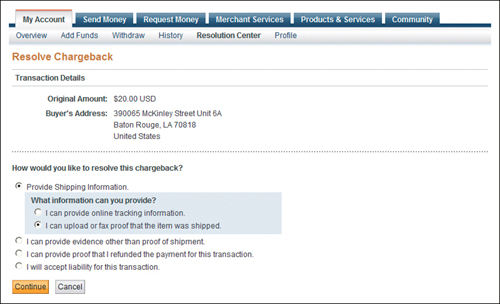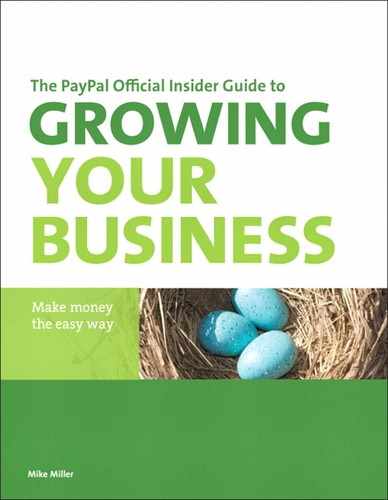11. Dealing with Disputes and Chargebacks

Disputes and chargebacks can be difficult to handle. PayPal’s systems can help—reducing the staff time and increasing customer’s satisfaction. This is especially true if you have limited staff available to handle customer concerns.
The experience of resolving an issue strongly affects your customer’s attitude and how they speak about you, for better or worse. Even if you’ve made a mistake, if you handle it well you often gain a customer for life!
If they don’t choose to contact you directly, a dissatisfied customer has two avenues for complaint: filing a dispute with PayPal, or initiating a chargeback with their credit card company.
Understanding Disputes
To resolve an issue, the first thing a customer can do is file a dispute with PayPal. This is typically done as part of the PayPal Purchase Protection program.
When a customer has a complaint about an item purchased using PayPal (the item wasn’t received or was significantly different than described), he files a dispute with PayPal. PayPal then freezes the associated funds in the merchant’s PayPal account while it examines the transaction.
If PayPal rules in the customer’s favor, the funds are withdrawn from the merchant’s PayPal account and returned to the customer. If PayPal rules in the seller’s favor, the funds are unfrozen and made available for use.
Understanding Chargebacks
A chargeback is similar to but different from a PayPal dispute in that it’s not filed with PayPal. Instead, a chargeback occurs when a buyer requests his credit card issuer to reverse a transaction after it has been completed. Some chargebacks are legitimate, made after a customer has tried to work out a solution with a merchant, but without success; in this instance, a chargeback is the aggrieved customer’s last means of recourse. Other chargebacks, however, are frivolous or even fraudulent, as customers try to avoid paying for legitimate purchases.
Most merchants hate credit card chargebacks even more than disputes; a chargeback is often a no-win situation, even for the most scrupulous sellers. Fortunately, PayPal can help you reduce chargebacks—and keep more money in your company’s pockets.
As soon as PayPal is notified of the chargeback, PayPal puts a hold on your account for the amount in dispute. This hold is lifted if the dispute is settled in your favor, or if the transaction qualifies for Seller Protection.
Naturally, chargebacks are available only to users who make a payment funded by their credit or debit card. They are initiated and handled by the buyer’s credit card issuer, not by PayPal. Therefore, the chargeback process follows the credit card issuer’s regulations and timeframes.
Dealing with Unwarranted Chargebacks
If you find yourself the victim of what you feel is an unwarranted chargeback, follow these steps:
1. Log in to your PayPal account, select the My Account tab, and then select the Resolution Center subtab.
2. From the Resolution Center page, shown in Figure 11.1, navigate to the item in dispute and click Respond.
3. When the Chargeback Details page appears, you’ll see the details about the nature of the chargeback. To respond to the case, click Resolve Chargeback Now at the bottom of the page.
Figure 11.1. PayPal’s Resolution Center.

Figure 11.2. Resolving a chargeback.

4. On the Resolve Chargeback page, shown in Figure 11.2, select the option that fits how you wish to remedy the chargeback. Each option has a few additional screens to complete in order to send the response to PayPal.
5. If you have any additional details to add to the case before it’s closed by PayPal, you can always add files, notes, or a fax to the case by returning to the Chargeback Details page and clicking the Add link next to the medium you wish to add. Note that this option goes away once PayPal has reviewed your response.
It’s then up to the credit card issuer to accept your version of the facts or to side with the complaining customer. If you win the argument, the chargeback is withdrawn.
You’ll find helpful Tutorials in PayPal’s Resolution Center which walk you through some typical situations.
Minimizing Disputes with PayPal’s Seller Protection
If you’re the victim of an unwarranted dispute or chargeback, you may be protected from any financial damages, thanks to PayPal’s Seller Protection program. As the name implies, this is a program designed to protect PayPal sellers from fraudulent transactions—as well as items lost or damaged in transit.
For those transactions eligible under the program, PayPal covers you in the event of unauthorized purchases, “item not received” claims, chargebacks, and reversals. PayPal protects you for the full amount of the eligible payment and waives any chargeback fees, if applicable.
A dispute is different from a chargeback, in that it’s a complaint filed by the customer before requesting a formal chargeback.
When You’re Covered
To be covered under the Seller Protection program, the following criteria must be met:
• The transaction is marked either fully or partially eligible.
• The item in question is a physical, tangible item that can be shipped, i.e., no digital goods.
• Your primary business address or residence, as listed for your PayPal account, is in the United States.
• You ship the item to a PayPal confirmed address, and this is the same address listed on the PayPal Transaction Details page.
• You ship within seven calendar days of being paid by the buyer.
• You keep proof of shipment and delivery so that the item can be tracked online.
• For payments over $250 USD, including shipping and tax, you have a signature confirmation of delivery in addition to proof of shipment.
What’s Not Covered
While most transactions are covered under Seller Protection, some are not. You’re not covered under the following circumstances:
• The item is picked up locally or delivered in person, rather than by a traditional shipping service.
• The item is not shipped to the recipient’s address. (This includes items originally sent to the recipient’s address but later redirected to a different address.)
• The item in question is a service, digital good, or intangible item.
• You receive multiple payments for the same item.
• Claims or chargebacks alleging that the item is significantly not as described.
• Payments received via PayPal Direct Payments, Virtual Terminal, or PayPal Business Payments.
Using PayPal Seller Protection
How do you benefit from PayPal’s Seller Protection Policy? It’s easy—and PayPal does all of the work for you.
You can tell whether a transaction qualifies for Seller Protection by examining the transaction details.
Seller Protection kicks in for eligible transactions when a buyer makes a claim against a seller for a transaction handled by PayPal. After the claim is filed, PayPal puts a temporary hold on the seller’s PayPal account for the amount in dispute. This hold stays in place while PayPal reviews the case.
If the transaction fits the requirements for Seller Protection, PayPal then releases the hold on the merchant’s funds. In this instance, you’re not out a penny.
If the transaction in question does not fit the requirements for Seller Protection, PayPal will deduct the appropriate funds from the seller’s account and transmit them to the buyer, as necessary.
The Bottom Line
Disputes and chargebacks are two ways for dissatisfied customers to gain refunds from a seller. PayPal’s Seller Protection program helps protect your eligible transactions against most unwarranted chargebacks from disreputable buyers. The program also helps protect against items legitimately lost or damaged in transit. Seller Protection is automatically launched when a customer files a claim against any eligible transaction; there’s nothing you have to do except let PayPal look into the matter.
